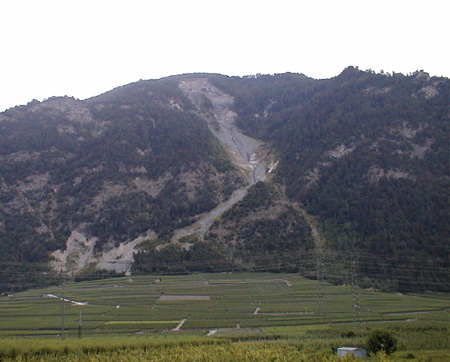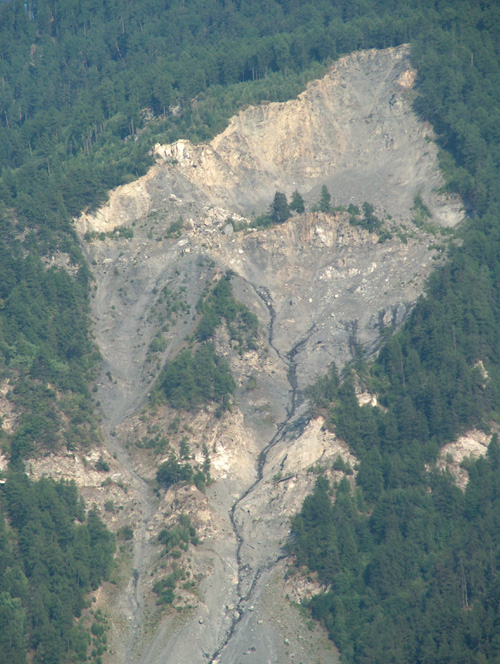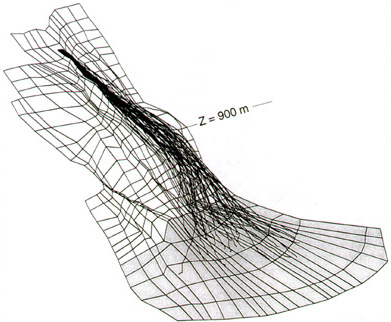The landslide of les Crétaux

Fig. 1: view to southeast of the Crétaux landslide.
The Crétaux landslide is located in a topographic depression indicating that it is a zone more erodible than its surroundings, probably caused by fractured zone (Figs. 1 and 2). In August 1985, approximately 800’000 m3 of an ancient cliff moved down to the valley in debris slides and rock fall. About 600’000 m3 reached the valley and 200’000 m3 remained perched within an active dislocated moving rock mass.
During the crisis of 1985 approximately 50 blocks of 100 kg to 100 tons – with an average of 10 tones – fell down from 1’400 m a.s.l. down to the Rhone valley at 450 m a.s.l..
It must be underlined that the video of the rockfalls permited to develop the program of trajectography 3D of the LMR (EPFL, Lausanne; (EBOUL; Descoeudres and Zimmerman 1987; Dudt and Heindenreich 2001) (Fig. 3).
Ditches are now build to protect the underlying vineyards.

Fig. 2 : View of the Crétaux landslide rock scarp and debris channel. Detailed view of the rock instability. Water seepage underlines the permanent activity of the cliff.

Fig. 3: 3D rockfall simulation (from Dudt and Heindenreich, 2001).
References :
Descoeudres, F. (1990): L’éboulement des Crétaux. Aspects géotechniques et calcul dynamique des chutes de blocs. Publ. Soc. Suisse de Mécanique des Sols et des Roches, 121: 19-25.
Descouedres, F., and Zimmermann, Th. 1987. Three-dimensional dynamic calculation of rockfalls. In Proceedings 6th International Congress of Rock Mechanics. Montreal, Canada, pp. 337-342.
Dudt, J.P., Heindenreich, B., 2001. Treatment of uncertainty in a three-dimensional numerical simulation model for rock falls. In M. Kühne, Einstein, H.H., Krauter, E., Klapperich, H., and Pötter, R. International Conference on Landslides, impacts and countermeasures. pp. 507 –514.
Labiouse, V., Heindenreich, B., Devareux, P., Viktorovitch, M. and Guillemin, P. (2001) : Etudes trajectographiques. In Programme Interreg IIc – “Falaises”, Prévention des mouvements de versants et des instabilités de falaises. Edited by Carere, K., Ratto, S. and Zanolini, F. Confrontation des méthodes d’études des éboulements rocheux dans l’arc alpin, pp. 155-211.
Rouiller, J.D. 1990. L’éboulement des crétaux – Isérables – Riddes (Valais). Publication Société Suisse de Mécanique des Sols et des Roches, 121: 15-17.
